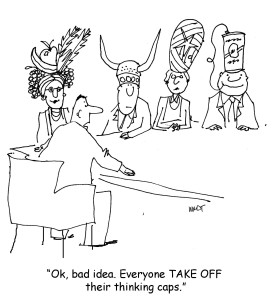Thinking About “Generative Thinking”
Posted: September 23, 2014
This month I write fresh from a two-day workshop on exponential fundraising led by Jennifer McCrea of Harvard’s Hauser Center for Nonprofit Organizations. I was invited to attend and, as I always do in such seasoned company, expanded my knowledge and thinking through both Ms. McCrea’s dynamic presentations and the considerable experience of my workshop fellows. As the ideas settle, I’ll be sharing strategies in my blog and dashboard.
One phrase that came up frequently during the two days was generative thinking –essentially that combination of creative thinking and problem solving without which there would be no innovation. The phrase has many implications for nonprofit boards and how they function – literally, to generate more ideas and solutions; to be in on the initiation of projects and not just rubber stamp the end. But creative thinking … problem solving … easy? You know the answer. I find myself mulling over how to prepare a board, and an organization for that matter, for more generative thinking.
Building Trust
When I talk about generative thinking, I don’t begin with brainstorming – I start with trust. Creativity doesn’t develop in a vacuum. Problems aren’t solved when people fear looking foolish if their ideas are dismissed. Board members must listen to each other, respect each other as equals, and place greater priority on group interaction and collaboration than individual glory. A board with that kind of affect is capable of generative thinking.
I’ve been beating the drum on board composition – and when building trust is vital, membership matters all the more. I won’t repeat myself here, but my recent blogs and dashboards have explored techniques for engaging the best board candidates and valuing listening as a critical communication skill. Attitude can make or break a board. Certainly there’s no room for arrogance or stuffy assumptions about “ideal” profiles when your goal is developing a board that can come together and govern through generative thinking.
Welcoming a Board as Catalyst
Another must-have is organizational leadership that encourages generative thinking. Otherwise there can be land mines if boundaries are sacrosanct. When boards get into a generative thinking mode, anything can be open to doing-it-better analysis: Are we approaching donors in the most creative way? Has a gala tradition run its course? Is our mission still in sync with modern realities or our cause’s evolving needs?
Generative thinking gives a board a different seat of power. It acquires a greater foundational role within an organization. You know that many board members are generative thinkers in their professional and personal lives, but much of the time they’re not asked to apply that creative/problem-solving talent to board governance. In a way, it’s the classic two heads are better than one – but multiply the potential advantage by your total board count. When your board and your organization are ready and willing, generative thinking can be a powerful catalyst for change and growth.
Looking for support in developing your board’s generative thinking? Let’s talk.
Cartoon by Chris Wildt

